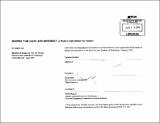Shaping time light and movement : a modern rail station for Boston
Author(s)
Lin, Juintow, 1973-
DownloadFull printable version (24.87Mb)
Alternative title
Modern rail station for Boston
Other Contributors
Massachusetts Institute of Technology. Dept. of Architecture.
Advisor
Shun Kanda.
Terms of use
Metadata
Show full item recordAbstract
After a century of neglect, due to investment in worldwide road construction and enlargements of airports, there is a renewed incentive to revive rail travel within the continental US. This motivation is derived from both the environmental benefits of the electric train as well as the ease of urban travel from regional city centers. The topic of the thesis is to investigate a new major rail stop at the site of Boston's North Station. The new station will be developed as a stop on a future high-speed rail line connecting Portland, Maine to Washington D.C. and to points beyond. On the local level, the station will serve as an urban gateway organizing the complex convergence of lines including subway, commuter, and long-distance railways. These factors should be actively controlled and made visibly and functionally comprehensible to the visitor. The incentive lies in creating a functionally simplistic pedestrian experience enhanced by a conscious recognition of the underlying historical and programmatic complexity. This thesis will embrace modern concepts of space-time in the practice of architectural design. This involves sensitive consideration of the perception of space relative to position and speed, light and movement. The design of a modern train station will be exploited as a means to making explicit the above issues in an architectural context. The goal is to create both organizational clarity as well as a dynamic aesthetic based on an explicit recognition of the movement of time through physical space. As the station will be located underground, a heavy emphasis must be placed on creating a strong connection between interior and exterior spaces. Much of the design is concentrated on the introduction of light to deep concourses and waiting platforms at all times of day with the intent to create temporal diversity of vibrant spaces for dynamic users. At the urban level, the building will attempt to convey a legible reading to the complex network of tunnels beneath the city street level. A building that acts much as urban sculpture will serve to bind a severed neighborhood and provide a public space that North Station deserves. In addition to being urban landmarks, rail stations are often the place of arrival and departure for visitors and residents alike, they are complex places where diverse functions and people intermingle, organize and get orientated. The thesis strives to resolve all these purposes in an architectural expression of space, light, structure and movement.
Description
Thesis (M.Arch.)--Massachusetts Institute of Technology, Dept. of Architecture, 2000. Includes bibliographical references (p. 117-119).
Date issued
2000Department
Massachusetts Institute of Technology. Department of ArchitecturePublisher
Massachusetts Institute of Technology
Keywords
Architecture.